

 |
AfroCubaWeb
|
 |
Cuban Abakuá Participate in the Ekpe Festival,
|
|||||||||||||||||||||||
|
|
| Ekpe leaders of Calabar receive Cuban Abakua delegation in a historic visit. Taken at the start of the Ekpe Festival in December 2004, this image depicts Cubans Vicente Sanchez (third from right) and 'Roman' Díaz (fifth from right in red wrapper) with Chiefs from the Efik, Efut, and Qua Ejagham peoples of Calabar. |
Preparing
the Ground, summer of 2004
 |
|
Miller with the late P.O.E. Bassey, Mgbe leader of Big Qua Town, and first indigenous High Court Judge in southeastern Nigeria. Bassey holds an Mgbe staff inherited from his great-grandfather. |
Traveling to Calabar in the Nigeria's Cross River Delta during the Summer
of 2004, Dr. Miller shared information
with Ekpe leaders and scholars about Cuban Abakua history, and the
desire of Cuban Abakua leaders to visit Calabar to confirm the source of their ancestral homeland
traditions.
In August 2004, Miller
gave a talk at the National Museum, Calabar. The panel, presented by Mr.
Nath Mayo Adediran, Museum Curator, included Etubom Bassey Ekpo
Bassey - Festival Founder, Etubom Ekpo Eyo - President of the Museum
Society, Dr. Ekpo Eyo - former director of the National Museum of Nigeria
and Professor Emeritus, University of Maryland, Scholar Jill Salmons - expert
on the expressive arts of the Cross River; Dr. Okon Uya - Chair of the
History Department, University of Calabar. At the request of Ekpe leaders,
Miller was dressed in traditional Ekpe attire, as were many in the
Miller at the podium at the
National Museum, Calabar
audience.

After the talk, Mr.
Larry Esin, Managing Director of Tourism, Cross River State, expressed a
commitment to bring a delegation of Cubans to Calabar for the Festival in December. After
months
of work, this became a reality.
This preliminary visit was written up in a Nigerian national paper as "A White Man's Passion for Ekpe," Daily Sun, 11/04

|
|
Ambassador Professor Uya, author of several books on the historical dimensions of the African Diaspora, comments after Miller's presentation. |
A
The
plan was to bring ten Cuban Abakua, but due to unforeseen
obstacles, only two arrived: Mr. Ogduardo 'Roman'
Díaz, who is
a title holder (Moni Bonko) of the Ekueri Tongo lodge of Havana; Mr. Vicente Sánchez,
a member (Abanékue) of the same. Both are professional
musicians currently living in New York City. The group, including Dr. Miller as translator, arrived to the Calabar airport December 19,
where they were received by a group
of Ekpe title holders, dressed in ceremonial clothing, who poured
libations on the tarmac, evoking their ancestors in this unprecedented
meeting.![]()
The Ekpe Festival
, Day 2
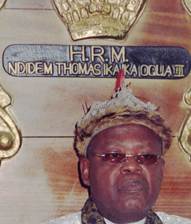
|
| His Royal Majesty Ndidem Thomas Ika Ika Ogua I, paramount ruler of the Quas. |
The next day, December 20, was the Festival commencement at the Big Qua Town Efe Mgbe. The Qua are a branch
|
|
|
'Roman' Díaz chants to the Qua court, evoking the Abakpa origins of the Abakua. |
of Ejagham speaking people known as Abakpa, the source term for the Cuban Abakua. We were received in the throne room by the Ndidem (king) of the Quas and Paramount Ruler of Calabar Municipality and his court. When the Cubans were presented to the Ndidem, Díaz and Sanchez chanted in honor of the Abakpa. We then exited to the street . . .
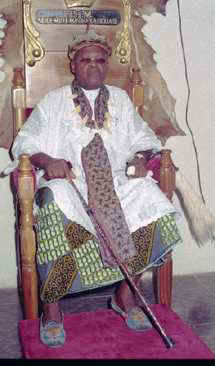 |
| His Royal Majesty Ndidem Thomas Ika Ika Ogua I, paramount ruler of the Quas, on his throne. |
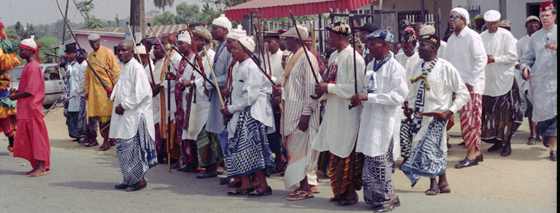
The Qua Ndidem leads the delegation to the street. At left, a masker and attendant in red, then local Ekpe leaders in charge of the Festival, with Díaz (in red wrapper and shades) and Sanchez to right. |
Seated with backs to the Big Qua Efe Ekpe (temple) and facing the Ndidem's throne room, libations were poured to commence the procession of Qua, Efut, and Efik Ekpe through Calabar Municipality to the Stadium.
|
|
The Ndidem of the Quas, with attendant in red at his back, pours libations to commence the festival.

Mr. Ekpo Ekang, the Youth Leader of the Efe Ekpe Eyo Ema (center in yellow wrap), accompanies various Ekpe masquerades as the procession passes through Big Qua Town.

At front and center, a Cuban Abakua mask is danced by an Ekpe member from Calabar. This mask, made in Matanzas, Cuba, in the 1990s, is now on display at the National Museum, Calabar.

|
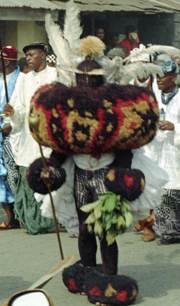 Calabar Ekpe masquerade. Note that both Cuban and Calabar mask use staff in right hand, herbs in left, and have no mouth. |
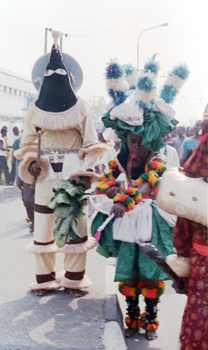
Cuban mask left, Calabar mask right. |

The procession moves through downtown Calabar. |
We danced, chanted, and 'flew
colors' from Big Qua Town along several main streets
of Calabar, through the Watts market, and to the Stadium, the
epicenter of the days’ public events. At the stadium,
the Ekpe Festival was declared open by the Deputy Governor, Elder
Dr. Walter Eneji, representing the Governor. Various Efe Ekpe (Ekpe logdes)
presented
their forms of Ekpe, and the Cuban mask was incorporated.![]() Since the event was
broadcast on local and national television, Diaz, Miller, and Sanchez were introduced, chanted in
Ekpe and Abakua, and then danced in the masquerade displays.
Since the event was
broadcast on local and national television, Diaz, Miller, and Sanchez were introduced, chanted in
Ekpe and Abakua, and then danced in the masquerade displays.
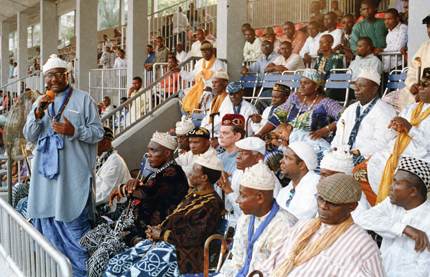
At the Stadium, Etubom Bassey Ekpe Bassey, Fesitval founder, greets the participants. In the second row, center are Miller, Sanchez, and Diaz.
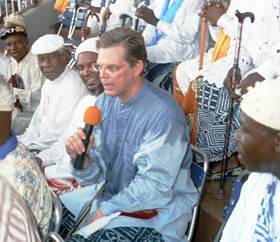
Miller chants Ekpe to the amusement of Sanchez and Diaz.![]()

In the Stadium, the Ekpe displays begin. Both these masks are called Ebongo. Díaz, Sanchez, and the Cuban mask are behind the mask at right.
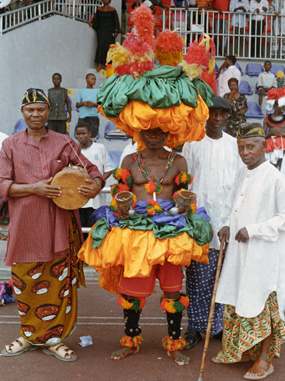
Calabar drum, mask and chief at the Stadium.
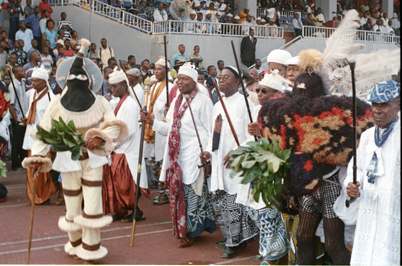
Cuban mask at left, with several leaders of Efe Ekpe Eyo Ema (Ekoretonko).
Díaz and Sanchez at right center, behind the front line.
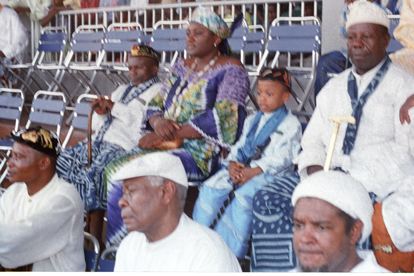
Roman Díaz, lower right, at the Calabar Stadium. Note young Ekpe member Eyo Bassey, top row, between Chief Oku of Efe Ekpe Essien Ekpe (Obioko), and Madame Edang Bassey.
That evening at
8 pm we arrived to the Governor’s palace for a command
performance by the theater troupe of the Calabar Cultural Center of “W
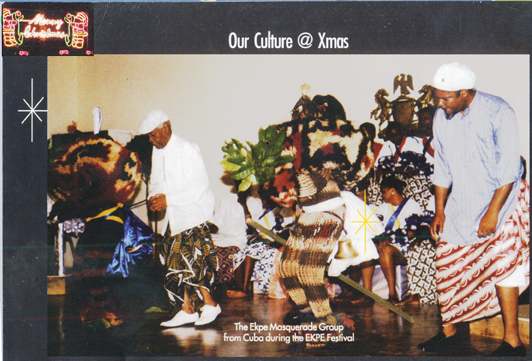
This photograph was published in MofiNews, a journal published by the Minister of Finance of Cross River State. Sanchez at left, Díaz at right.
A
consummate artist, Díaz did a fantastic job of communicating with the audience through
Abakua chants and dance gestures, while Sanchez communicated through the bonkó
drum, brought from Cuba. Because the Cuban chanting vocabulary is
extensive, Diaz was able to tailor his various performances to the ethnic identity of each
group we met, whether
Efik, Efut, Qua Ejagham, Ibibio, Oron, Igbo, since each of these groups
are represented in Cuban Ekpe.
Headline from Calabar Newspaper with scene from the Festival:
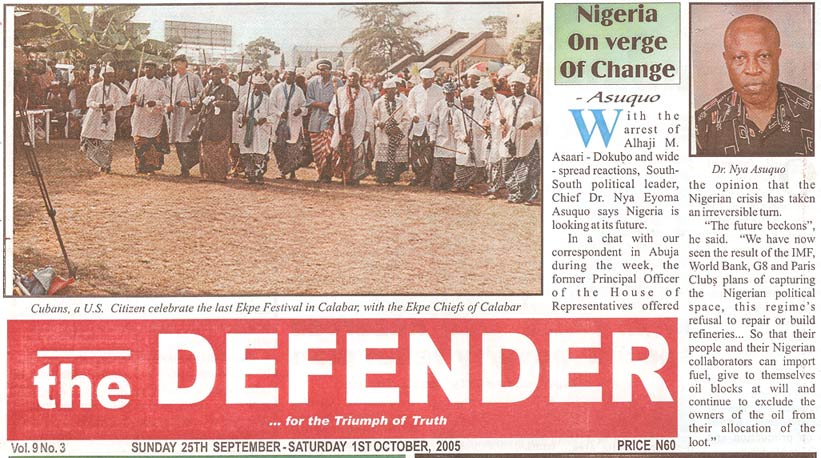
Text by Dr. Ivor Miller, April 2005
All photos copyright 2004 by Mr. Mpkan Ekpe Bassey, Ekpe member, Calabar
Visit to the Ekoretonko Lodge
Visit to the Obutong Ekpe Lodge
Follow up, 2005
See Etubom Asuquo Etim: maskmaker, musician
for a page on a Calabar artist working in this tradition.
See also our Abakuá page.
Also, for the impact this visit has had in the Cross River Delta:
Cuban Abakuá fueling a resurgence of traditional Ekpe values in Cross River Delta, Nigeria - Statement by ‘Iberedem’ Fred Eno Essien, ‘Ukai’ of Ibibioland, and prominent Ekpe leader from Uruan, 1/08 Chief Ekpenyong Eyo Honesty Eyo II, reflects upon the impact that knowledge of Cubban Abakua is having upon Ekpe leaders of the Cross River region, 1/08
[AfroCubaWeb] [Site Map] [Music] [Arts] [Authors] [News] [Search this site]